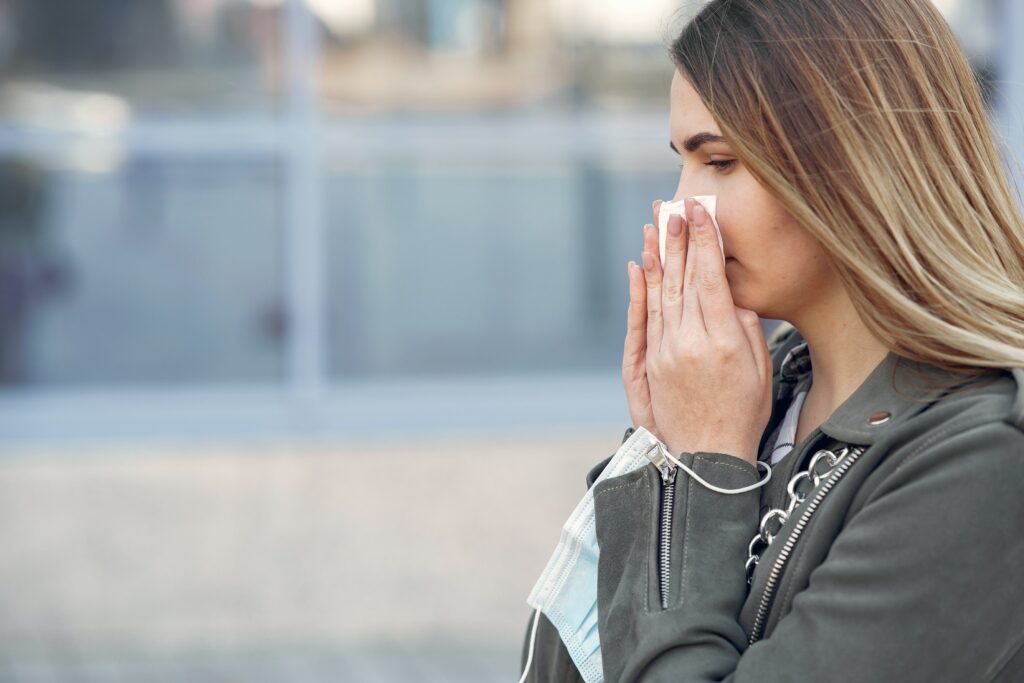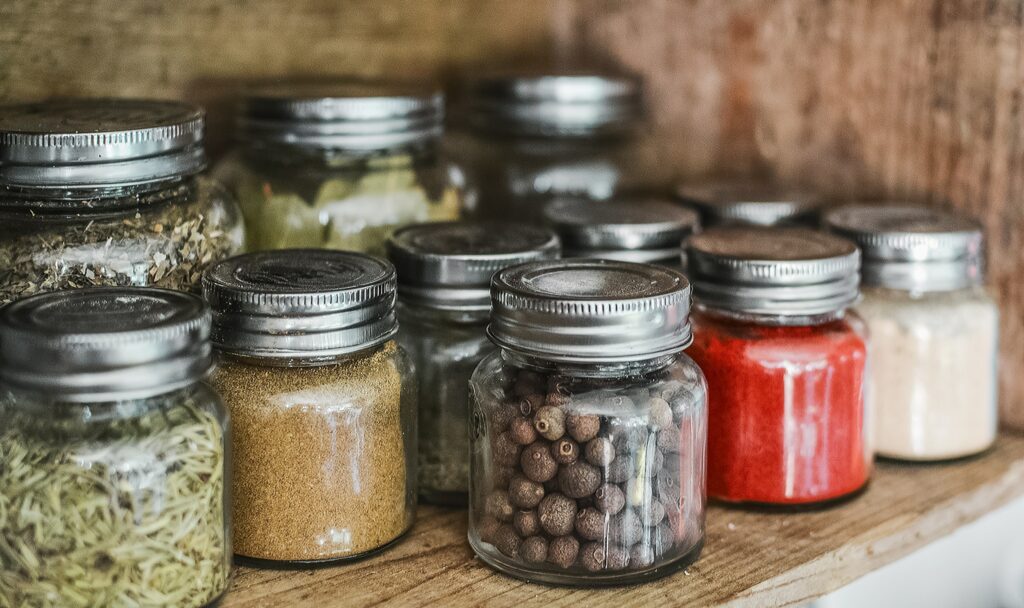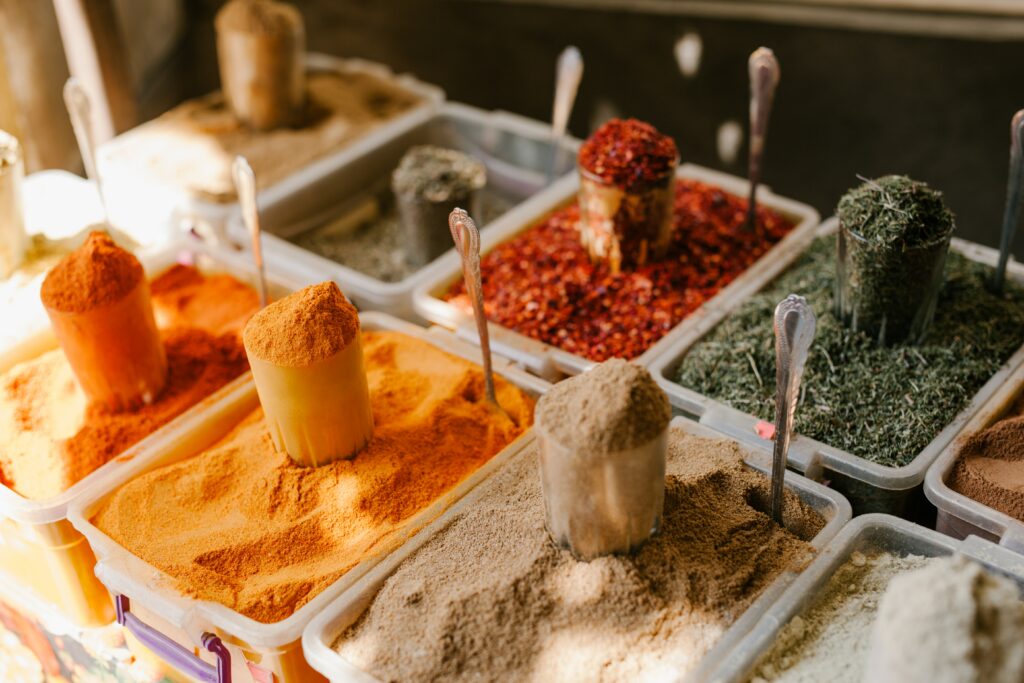Hay fever is another immune system derangement and relates to hypersensitivity of the nervous system.
It is also showing a disorder in the digestive system.


Vata type Hay fever
It is usually a Vata disorder because vata types are the most sensitive, however pitta and kapha types exists.
Vata allergies are cause by dust, wind, dryness and manifest more in autumn. Vata symptoms are cough with a little phlegm, headache, insomnia, restlessness and anxiety
Pitta type Hay fever
Pitta dosha is involved in the more severe allergies with toxic blood and symptoms or fever, red eyes and rashes.
Allergies of Pitta are caused by heat and sun light and manifest more in the summer. Pitta symptoms are burning eyes, thirst, fever, yellow nasal discharge and skin rashes.


Kapha type Hay fever
Kapha get allergies along with their general accumulation of dampness and mucus. Hay fever most often occurs in a weaker debilitated constitution.
Kapha allergies are cause by dampness and mold and manifest more in the spring. Kapha symptoms are abundant clear or white phlegm, dullness and heaviness.
Remedies to treat your allergies


In acute conditions the treatment for allergies is similar to that for the common cold, with a detoxifying diet.
Then, dairy and other mucus forming foods should be avoided.
Between attacks, however, it is important to strengthen the immune system and the lungs, particularly for vata constitution.
For this tonification therapy, important ayurvedic herbs are ashwaghanda and bala; Chinese herbs are ginseng and astralagus and western comfrey root. Chyawanprash is a good general tonic to take.
First determine what is your allergies type
Because you need to choose the right treatment. If you have some doubts about it, ask an ayurvedic professional that I’m also.
All kinds of hay fever require special herbs to clear the sinuses, open the head and dispel phlegm.
Kapha, Pitta and Vata remedies
For kapha, the old standby Trikatu is good or dry ginger powder as a snuff.
Ayurvedic herbs include calamus, gotu kola, ginger, cloves, camphor (in very small amount) ephedra and bayberry. Calamus ghee applied in the nose is excellent. Gotu kola oil or ghee is similarly used for Pitta conditions.
Chinese herbs include magnolia flower, xanthium (cocklebur), mint, angelica, wild ginger and chrysanthemum. Additional western herbs are peppermint, sage, eucalyptus, wintergreen, bay leaves and mullein flowers.
When Pitta is involves, bitters and blood cleansing herbs such as echinacea, barberry, dandelion and burdock must be added.
Essential oil like menthols, eucalyptus or camphor or a paste of spicy herbs like ginger can be applied to the temple or root of the nose. Sandalwood oil on the forehead is good when there are hot or febrile sensation.
For red, itchy eyes, ghee particularly made with triphala can be applied to the eyelids.
Triphala ghee is best and ghee by itself is helpful. Chamomile, eyebright or chrysanthemum in lukewarm infusions can be used to wash the eyes.
A good formula also for hay fever is gotu kola, calamus, angelica, wild ginger and licorice in equal parts of the powders.
Basil tea (particularly holy basil or tulsi) is good taken with honey. Coriander and cilantro (coriander leaf) are best for Pitta.
Vata and Kapha types can take this with honey. Also, a lung tonic can be taken.
Other good treatments


Nasya therapy
Nasya therapy or nasal application of herbs and oils is important not only for hay fever and sinusitis but also for all diseases of the head and sinuses. Simply put 2 drops or medicated oil into the nostril with the help of eyedropper. Vata types should take licorice in sesame oil (name of the oil: anu tailam). Do it daily.
Pitta types should take gotu kola in sesame oil or Brahmi oil, and Kapha types should take calamus, eucalyptus or camphor in sesame oil.
Neti pot
Yoga employs a small pot for pouring water in the nose to clean the nostrils. This is called neti pot. Wash the nostrils with a saline solution, it works wonder in many allergies cases.
Usually, one takes about 1/8 teaspoon or a pinch of salt in the neti pot. But you can also add a little sesame oil and a little of the powder ginger or calamus for a stronger action. This opens the head and sinuses and remove phlegm and congestion. In very congested conditions a snuff of herbal powders or an application of oils works better than the neti pot.
Detoxifying: the ginger detox bath
Why ginger bath is so effective?:
- Relaxes the body and mind
- Detoxifies the body
- Increases circulation
- Promotes healthy digestion and metabolism
- Induces sweating
- Anti-inflammatory
- Reduces aches, pains, soreness and swelling in the body
- Decreases a fever
- Reduces stress
- Calms the mind
- Enhances detoxification before, during and after a cleanse
- Beneficial during illness
- Beneficial in weight loss programs
How to make it?
- 1/4 cup of organic dried ginger powder
- Lavender and rosemary essential oils (optional but recommended)
- 1/4 cup of baking soda
- Medicated massage oil to apply after the bath (optional but recommended)
- 1/4 cup of plain, unscented Epsom salt
- Fulfill your tub with hot water. If you are Pitta types use warm to avoid increasing Pitta.
- When the bathtub is about half way full, add the ginger, baking soda and Epsom salt, 5-7 drops of both the lavender and the rosemary essential oil (optional).
- Dissolved all the ingredients into the hot water and stop fulfilling bath to the desired amount.
- Lie in the bath for a minimum of 15 minutes or until a sweat breaks
- Take a quick shower to rinse off any residue on your body.
- Apply a medicated massage oil such as Vata Oil, Pitta Oil or Kapha Oil directly after drying off to heal and balance the body and nervous system also. This is especially beneficial for Vata and Pitta types, due to the drying and heating potential respectively.
Change the bad habits and turn them in health daily lifestyle:
Here some general advices that you can practice for all constitution. Other specific practices exists specifically for your constitution. But you can apply that if you don’t want to go further in your personalized daily routine:
- Wake up each day around 6-7am
- Practice gandusha each morning with oil such your doshas
- Scub your tongue each morning
- Perform a self oil massage at least 2 times a week with oil.. depend on your constitution
- 20-30 minutes daily exercises regimen each day such as walking, swimming, bicycling or yoga
- Avoid daytime sleeping
- Surya Namaskara (sun salutation)
- Kapala Bati pranayama
- Daily meditation
As you can see, many methods can be use to treat each allergy types.
But choose one remedies on the list that most pertain to your symptoms, and also that you can realistically do.
So, remember consistency is The key for an effective treatment!
Since I’m sharing with you, you know that herbal remedies are a complimentary treatment to do with a healthy diet and lifestyle, however if you don’t have healthy diet and lifestyle you should think about it … changes required. Without these changes, you will pacify the symptoms and not treated the root cause of the allergy.
As always please contact me if you have any questions or comments!
And for more tips about your healthy lifestyle with ayurveda, practice with my blog.
References
The relationship of rhinitis and asthma, sinusitis, food allergy, and eczema – PubMed (nih.gov)
[Respiratory allergies] – PubMed (nih.gov)
Seasonal ocular allergy and pollen counts – PubMed (nih.gov)
Seasonal allergic rhinitis and the role of apitherapy – PubMed (nih.gov)
